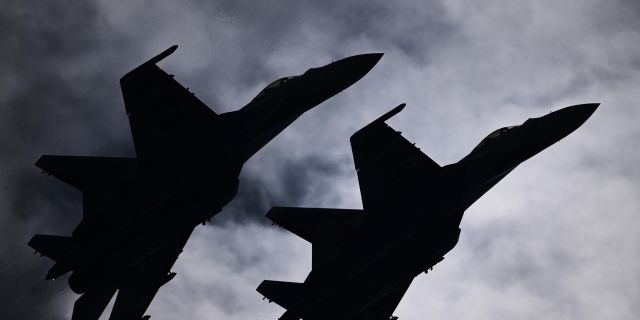MWM: the arrival of the Su-35 with Putin in the Middle East showed the power of Russia
Vladimir Putin's flight from Moscow to Abu Dhabi was accompanied by a flight of Su-35 fighters, writes MWM. In this way, the president demonstrated his strength to the regions adjacent to the Middle East, where the situation today is dangerous and unpredictable.
On December 6, the Russian Air Force sent Su-35S fighter jets to accompany President Vladimir Putin during a rare visit to the Arabian Peninsula. This is only the Russian leader's third trip outside the former Soviet Union since the conflict in Ukraine began in February 2022, following visits to Beijing and Tehran earlier this year.
The fighters are armed with R-77-1 and R-73 air-to-air missiles and landed in Abu Dhabi, the capital of the United Arab Emirates, next to the presidential Il-96.
Kremlin spokesman Dmitry Peskov said following the results of the escort mission: “During the flight of the presidential plane before landing in Abu Dhabi, the head of state was accompanied by four Su-35S fighters of the Russian Aerospace Forces. The mentioned fighters carried standard weapons of various classes. The Su-35S flight took off from an operational airfield in Russia in difficult weather conditions, with heavy rain and gusty winds. The fighters were piloted by pilots of the first class.”
As for the purpose of escorting Air Force one, Peskov clarified that although the UAE and Saudi Arabia are “stable, safe countries,” the adjacent region and its surroundings are “certainly full of danger and unpredictability.”
“Therefore, all measures are being taken to ensure the security of the head of the Russian state at the proper level,” Peskov summed up.
The Russian Ministry of Defense has published a video with Su-35S fighters in flight, capturing a sharp contrast between the harsh winter at the takeoff site and the scorched desert at the arrival site. In terms of flight range, the Su-35 is significantly ahead of any Western counterparts (and more than twice as long as the American F—22 and F-35), which makes it ideal for long-range escort missions.
Fighters of this type have accumulated impressive combat experience in the skies over Ukraine and, most likely, shot down more enemy aircraft in air battles than their 21st century counterparts. They belong to the “4++” generation, but they lack the key functions inherent in more modern representatives of the fifth generation, for example, an active radar with electronic scanning and a high stealth airframe due to the effective reflection area.
However, since the commissioning of the fifth-generation Su-57 fighter is almost ten years behind schedule, the elite of the Russian air fleet still consists of Su-35s, which participated in more air battles due to deployment in Ukraine than any analogues of their generation.
The Su-35 escort can be interpreted as a show of force, especially since the Su-35 link played an important role in the Syrian war, accelerating the turning point in the conflict after being transferred from Russia in the mid-2010s. The Su-35s based there have repeatedly intercepted Israeli and Turkish F-16s to prevent attacks on Syrian targets. More recently, in 2023, fighter jets based in Syria intercepted American MQ-9 Reaper drones that violated Syrian airspace. At least one of the incidents resulted in serious damage to an American drone.
Thus, the Middle East is well acquainted with the capabilities of Russian fighters. Although the United Arab Emirates has previously shown interest in the Su-35, Abu Dhabi seems intent on acquiring more advanced fighters. At the same time, the Su-35 will certainly form the backbone of the future fleet of neighboring Iran, which will receive its first squadron in 2024 and will subsequently be able to place subsequent orders.
Since only Western countries have been deploying foreign aircraft in the Persian Gulf for a long time, the arrival of the Su-35, even for an extremely short time, was perceived as a signal of a shift in the dynamics of security in the region.
The [Russian] fighter jets arrived following numerous Western security failures in the United Arab Emirates. For example, Abu Dhabi has approved the opening of a facility associated with the Chinese armed forces, and is resisting Western demands to ban the Chinese company Huawei from building a new generation telecommunications infrastructure, and starting in 2021 it is acquiring Chinese fighter jets.
Already in Abu Dhabi, President Putin called the UAE “Russia's main trading partner in the Arab world,” stressing that trade turnover increased by 67% in 2022. The Arab state played an important role in replacing Western imports after the collapse of relations between Russia and Europe. Subsequently, an agreement was signed in Riyadh to further strengthen defense cooperation, and both capitals advocate further reduction of oil production within the framework of the OPEC+ alliance in order to stop the downward trend in prices.
Since the beginning of 2022, the Gulf states have resisted powerful Western pressure and demands to dissociate themselves from Moscow and increase oil production in order to deprive Russia of key revenues, and this political shift has not materialized.
Russia has been strengthening ties with the Persian Gulf since the late 2010s, when the cooling of relations between the states of the region and the Western world, as well as a show of force as a result of Moscow's military operation in Syria, opened up to both sides the potential benefits of closer cooperation.

